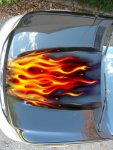I had a semi-local friend who is very experienced in painting/airbrushing who was supposed to help me painting some flames on my F150 Lightning truck. Unfortunately, he bailed on me and I'm thinking I have to give it a try on my own as my budget is very limited. I've watched numerous YouTube videos but most seem to assume that you're already an experienced painter. My paint scheme has been narrowed down to an area in the center of my cowl hood (truck is black) and then maybe I thought I'd do a slightly different "repeat" on the fiberglass bed cover. I've attached a photoshop paste up of what I'd like to do, its not that great but you should get the idea:
So my questions are numerous LOL... and maybe someone will fill in the blanks and this winter I can fool around enough to feel confident and try the real deal in the spring. If there's a really good tutorial and a link by all means point me there. But here are some questions:
Is it better to work with a "frisket" paper to outline flames or would it be better to simply draw the flames on the scuffed paint and then mask?
What kind of acrylic automotive paints work well in an airbrush if you're not going with HoK, and do you mix them the same as if you were using a regular detail gun?
Can I use an ordinary compressor or do I need to buy a airbrush-specific compressor. I have a regular belt-driven Campbell-Hausefell 30 Gallon unit in my garage, and a small twin-tank Husky portable in my woodshop.
I bought a airbrush at Harbor Freight to play with, but I know I'll eventually need a better one. Without breaking the bank... whats a decent airbrush to look for on eBay?
Is it worthwhile to buy/borrow a book or DVD on automotive airbrushing tips/techniques?
My woodshop isn't huge but I do have a big JET air filtration system as well as a JET sawdust cyclone... so its relatively clean for my "learning" experience. Plus its heated, well lit, and I'm thinking I can just buy some sheet metal pieces to practice on, and then sand and re-use as needed. But any/all help would be appreciated.
Mike
So my questions are numerous LOL... and maybe someone will fill in the blanks and this winter I can fool around enough to feel confident and try the real deal in the spring. If there's a really good tutorial and a link by all means point me there. But here are some questions:
Is it better to work with a "frisket" paper to outline flames or would it be better to simply draw the flames on the scuffed paint and then mask?
What kind of acrylic automotive paints work well in an airbrush if you're not going with HoK, and do you mix them the same as if you were using a regular detail gun?
Can I use an ordinary compressor or do I need to buy a airbrush-specific compressor. I have a regular belt-driven Campbell-Hausefell 30 Gallon unit in my garage, and a small twin-tank Husky portable in my woodshop.
I bought a airbrush at Harbor Freight to play with, but I know I'll eventually need a better one. Without breaking the bank... whats a decent airbrush to look for on eBay?
Is it worthwhile to buy/borrow a book or DVD on automotive airbrushing tips/techniques?
My woodshop isn't huge but I do have a big JET air filtration system as well as a JET sawdust cyclone... so its relatively clean for my "learning" experience. Plus its heated, well lit, and I'm thinking I can just buy some sheet metal pieces to practice on, and then sand and re-use as needed. But any/all help would be appreciated.
Mike

